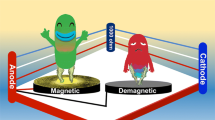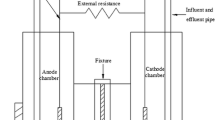Abstract
Microbial fuel cells (MFCs) have emerged as a promising technology for wastewater treatment with concomitant energy production but the performance is usually limited by low microbial activities. This has spurred intensive research interest for microbial enhancement. This study demonstrated an interesting stimulation effect of a static magnetic field (MF) on sludge-inoculated MFCs and explored into the mechanisms. The implementation of a 100-mT MF accelerated the reactor startup and led to increased electricity generation. Under the MF exposure, the activation loss of the MFC was decreased, but there was no increased secretion of redox mediators. Thus, the MF effect was mainly due to enhanced bioelectrochemical activities of anodic microorganisms, which are likely attributed to the oxidative stress and magnetohydrodynamic effects under an MF exposure. This work implies that weak MF may be applied as a simple and effective approach to stimulate microbial activities for various bioelectrochemical energy production and decontamination applications.





Similar content being viewed by others
References
Afanasyeva MS, Taraban MB, Purtov PA, Leshina TV, Grissom CB (2006) Magnetic spin effects in enzymatic reactions: radical oxidation of NADH by horseradish peroxidase. J Am Chem Soc 128:8651–8658
Borole AP, Hamilton CY, Vishnivetskaya T, Leak D, Andras C (2009) Improving power production in acetate-fed microbial fuel cells via enrichment of exoelectrogenic organisms in flow-through systems. Biochem Eng J 48:71–80
Borole AP, Reguera G, Ringeisen B, Wang ZW, Yj Feng, Kim BH (2011) Electroactive biofilms: current status and future research needs. Energy Environ Sci 4:4813–4834
Chen YP, Li R, He JM (2011) Magnetic field can alleviate toxicological effect induced by cadmium in mungbean seedlings. Ecotoxicology 20:760–769
Di Lorenzo M, Scott K, Curtis TP, Head IM (2010) Effect of increasing anode surface area on the performance of a single chamber microbial fuel cell. Chem Eng J 156:40–48
Filipic J, Kraigher B, Tepus B, Kokol V, Mandic-Mulec I (2012) Effects of low-density static magnetic fields on the growth and activities of wastewater bacteria Escherichia coli and Pseudomonas putida. Bioresour Technol 120:225–232
Ji Y, Wang Y, Sun J, Yan T, Li J, Zhao TT, Yin XH, Sun CJ (2010) Enhancement of biological treatment of wastewater by magnetic field. Bioresour Technol 101:8535–8540
Jones AR, Hay S, Woodward JR, Scrutton NS (2007) Magnetic field effect studies indicate reduced geminate recombination of the radical pair in substrate-bound adenosylcobalamin-dependent ethanolamine ammonia lyase. J Am Chem Soc 129:15718–15727
Katz E, Lioubashevski O, Willner I (2005) Magnetic field effects on bioelectrocatalytic reactions of surface-confined enzyme systems: enhanced performance of biofuel cells. J Am Chem Soc 127:3979–3988
Kriklavova L, Truhlar M, Skodova P, Lederer T, Jirku V (2014) Effects of a static magnetic field on phenol degradation effectiveness and Rhodococcus erythropolis growth and respiration in a fed-batch reactor. Bioresour Technol 167:510–513
Łebkowska M, Rutkowska-Narozniak A, Pajor E, Pochanke Z (2011) Effect of a static magnetic field on formaldehyde biodegradation in wastewater by activated sludge. Bioresour Technol 102:8777–8782
Li WW, Sheng GP, Liu XW, Yu HQ (2011a) Recent advances in the separators for microbial fuel cells. Bioresour Technol 102:244–252
Li WW, Sheng GP, Liu XW, Cai PJ, Sun M, Xiao X, Wang YK, Tong ZH, Dong F, Yu HQ (2011b) Impact of a static magnetic field on the electricity production of Shewanella-inoculated microbial fuel cells. Biosens Bioelectron 26:3987–3992
Li WW, Yu HQ, He Z (2014) Towards sustainable wastewater treatment technologies by using microbial fuel cells–centred technologies. Energy Environ Sci 7:911–924
Liu S, Yang F, Meng F, Chen H, Gong Z (2008) Enhanced anammox consortium activity for nitrogen removal: impacts of static magnetic field. J Biotechnol 138:96–102
Logan BE, Hamelers B, Rozendal RA, Schrorder U, Keller J, Freguia S, Aelterman P, Verstraete W, Rabaey K (2006) Microbial fuel cells: methodology and technology. Environ Sci Technol 40:5181–5192
Lovley DR (2008) The microbe electric: conversion of organic matter to electricity. Curr Opin Biotechnol 19:564–571
Lovley DR (2011) Live wires: direct extracellular electron exchange for bioenergy and the bioremediation of energy-related contamination. Energy Environ Sci 4:4896–4906
Luo HP, Liu GL, Zhang RD, Jin S (2009) Phenol degradation in microbial fuel cells. Chem Eng J 147:259–264
Mathuriya AS (2014) Eco-affectionate face of microbial fuel cells. Crit Rev Environ Sci Technol 44:97–153
Mohanakrishna G, Mohan SK, Mohan SV (2012) Carbon based nanotubes and nanopowder as impregnated electrode structures for enhanced power generation: evaluation with real field wastewater. Appl Energy 95:31–37
Pant D, Van Bogaert G, Diels L, Vanbroekhoven K (2010) A review of the substrates used in microbial fuel cells (MFCs) for sustainable energy production. Bioresour Technol 101:1533–1543
Pant D, Singh A, Van Bogaert G, Olsen SI, Nigam PS, Diels L, Vanbroekhoven K (2012) Bioelectrochemical systems (BES) for sustainable energy production and product recovery from organic wastes and industrial wastewaters. RSC Adv 2:1248–1263
Pham TH, Aelterman P, Verstraete W (2009) Bioanode performance in bioelectrochemical systems: recent improvements and prospects. Trends Biotechnol 27:168–178
Sheng GP, Yu HQ (2006) Characterization of extracellular polymeric substances of aerobic and anaerobic sludge using three-dimensional excitation and emission matrix fluorescence spectroscopy. Water Res 40:1233–11239
Solanki K, Subramanian S, Basu S (2013) Microbial fuel cells for azo dye treatment with electricity generation: a review. Bioresour Technol 131:564–571
Sun SY, Xu YB (2010) Effect of stable weak magnetic field on Cr(VI) bio-removal in anaerobic SBR system. Biodegradation 19:455–462
Sun M, Sheng GP, Zhang L, Liu XW, Xia CR, Mu ZX, Wang HL, Yu HQ, Qi R, Yu T, Yang M (2008) An MEC-MFC-coupled system for biohydrogen production from acetate. Environ Sci Technol 42:8095–8100
Sun M, Mu ZX, Sheng GP, Liu XW, Zhang L, Xia CR, Wang HL, Tong ZH, Yu HQ (2011) Effects of a transient external voltage application on the bioanode performance of microbial fuel cells. Electrochim Acta 55:3048–3054
Tao QQ, Zhou SQ (2014) Effect of static magnetic field on electricity production and wastewater treatment in microbial fuel cells. Appl Microbiol Biotechnol 98:9879–9887
Torres CI, Marcus AK, Lee HS, Parameswaran P, Krajmalnik-Brown R, Rittmann BE (2010) A kinetic perspective on extracellular electron transfer by anode-respiring bacteria. FEMS Microbiol Rev 34:3–17
Wang ZW, Wu ZC, Tang SJ (2009) Characterization of dissolved organic matter in a submerged membrane bioreactor by using three-dimensional excitation and emission matrix fluorescence spectroscopy. Water Res 43:1533–1540
Wang YP, Liu XW, Li WW, Li F, Wang YK, Sheng GP, Zeng RJ, Yu HQ (2012) A microbial fuel cell-membrane bioreactor integrated system for cost-effective wastewater treatment. Appl Energy 98:230–235
Wang HY, Wang GM, Ling YC, Qian F, Song Y, Lu XH, Chen SW, Tong YX, Li Y (2013) High power density microbial fuel cell with flexible 3D graphene-nickel foam as anode. Nanoscale 5:10283–10290
Xiang K, Qiao Y, Ching CB, Li CM (2009) GldA overexpressing-engineered E. coli as superior electrocatalyst for microbial fuel cells. Electrochem Commun 11:1593–1595
Yin Y, Huang GT, Tong YR, Liu YD, Zhang LH (2013) Electricity production and electrochemical impedance modeling of microbial fuel cells under static magnetic field. J Power Sources 237:58–63
Zaidi NS, Sohaili J, Muda K, Sillanpaa M (2014) Magnetic field application and its potential in water and wastewater treatment systems. Sep Purif Rev 43:206–240
Zhang CY, Liang P, Jiang Y, Huang X (2015) Enhanced power generation of microbial fuel cell using manganese dioxide-coated anode in flow-through mode. J Power Sources 273:580–583
Zhou M, Chi M, Luo J, He H, Jin T (2011) An overview of electrode materials in microbial fuel cells. J Power Sources 196:4427–4435
Acknowledgments
The authors wish to thank the Natural Science Foundation of China (51278479 and 21261160489) for the partial support of this study.
Author information
Authors and Affiliations
Corresponding author
Ethics declarations
Conflict of interest
All authors declare that they have no conflict of interest.
Rights and permissions
About this article
Cite this article
Tong, ZH., Yu, HQ., Li, WW. et al. Application of a weak magnetic field to improve microbial fuel cell performance. Ecotoxicology 24, 2175–2180 (2015). https://doi.org/10.1007/s10646-015-1545-2
Accepted:
Published:
Issue Date:
DOI: https://doi.org/10.1007/s10646-015-1545-2




